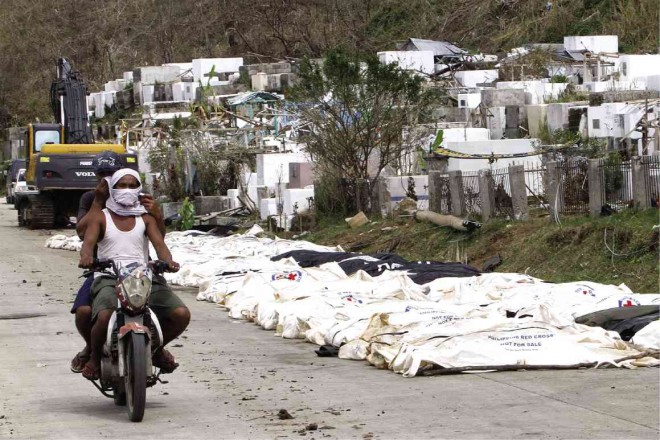32 days after ‘Yolanda,’ city still counting dead
TACLOBAN CITY—A month after Supertyphoon “Yolanda” wrought havoc on central Philippines, this city is still counting the dead as workers continue to find bodies, raising the possibility of the death toll exceeding the original estimate of 10,000.
As of Monday, the death toll here was 2,321, but Senior Supt. Pablito Cordeta, head of the government task force searching for bodies, said that figure would surely rise as the water had receded and workers reached parts of the city that had been under water or buried under typhoon debris.
The National Disaster Risk Reduction and Management Council (NDRRMC) in Manila reported the death toll at 5,924, with 1,779 people missing.
International aid agencies find the official figures low, as flights over the region three days after Yolanda (international name: “Haiyan”) struck on Nov. 8 reported thousands of bodies floating in the water.
The missing now number 8,000, but the NDRRMC counts only reports passing through the approved official layers.
Under that system, local officials and health officers must submit reports of identified fatalities and missing, a tedious process that slows the count.
But even the current official death toll already exceeds the 2,000-2,500 estimate cited by President Aquino in an interview with CNN last month in which he rejected the 10,000 estimate of local officials.
Buried uncounted
Chief Supt. Rafael Soria, police director for Eastern Visayas, was sacked for talking to the press about that estimate, which was not his but only mentioned to him by Leyte Gov. Dominic Petilla who had given him a briefing after a meeting with village officials on Nov. 9.
Officials fear the missing may be among the unidentified fatalities who have not been counted and whose bodies have been buried in common pits to prevent the outbreak of disease in the typhoon-ravaged communities.
In Tacloban, Cordeta said the death toll included only the bodies that his group had found since Nov. 15.
Cordeta refused to comment on a statement by City Administrator Tecson John Lim citing “unconfirmed reports” that bodies found along the seaside were not counted and were buried by the people who found them.
Cordeta said, however, that his group finds 20 to 40 bodies a day along the coast.
The bodies are placed in body bags and carried to mass graves in Basper and Suhi villages for temporary burial, he said.
Body disposition
Lim said identifying the bodies was slow because there were only 10 forensic officers from the National Bureau of Investigation doing it with assistance from 20 people from the city.
People looking for missing relatives can go to Suhi, where the NBI is identifying and recording the dead, he said.
Lim said the identification of the bodies was slowed by the NBI’s following international guidelines for body disposition.
The guidelines include taking photographs of the dead and samples for DNA testing that can help families identify their missing relatives.
According to Lim, the guidelines prohibit the publication of information gathered by the forensic officers to protect the privacy of the dead.
Memorial park
Lim said moving the typhoon dead to their final resting places was “very difficult,” but the city government was looking to expropriate a 1.8-hectare property in the private Holy Cross cemetery in Diit village here to build a memorial park for those who died in the storm.
The cost of burying the victims would reach P20 million to P30 million, excluding the price of the land, Lim said.—With a report from Robert Gonzaga, Inquirer Central Luzon
Originally posted: 10:12 pm | Monday, December 9th, 2013
RELATED STORIES:
Disaster official denies scheme to lower ‘Yolanda’ death toll



















